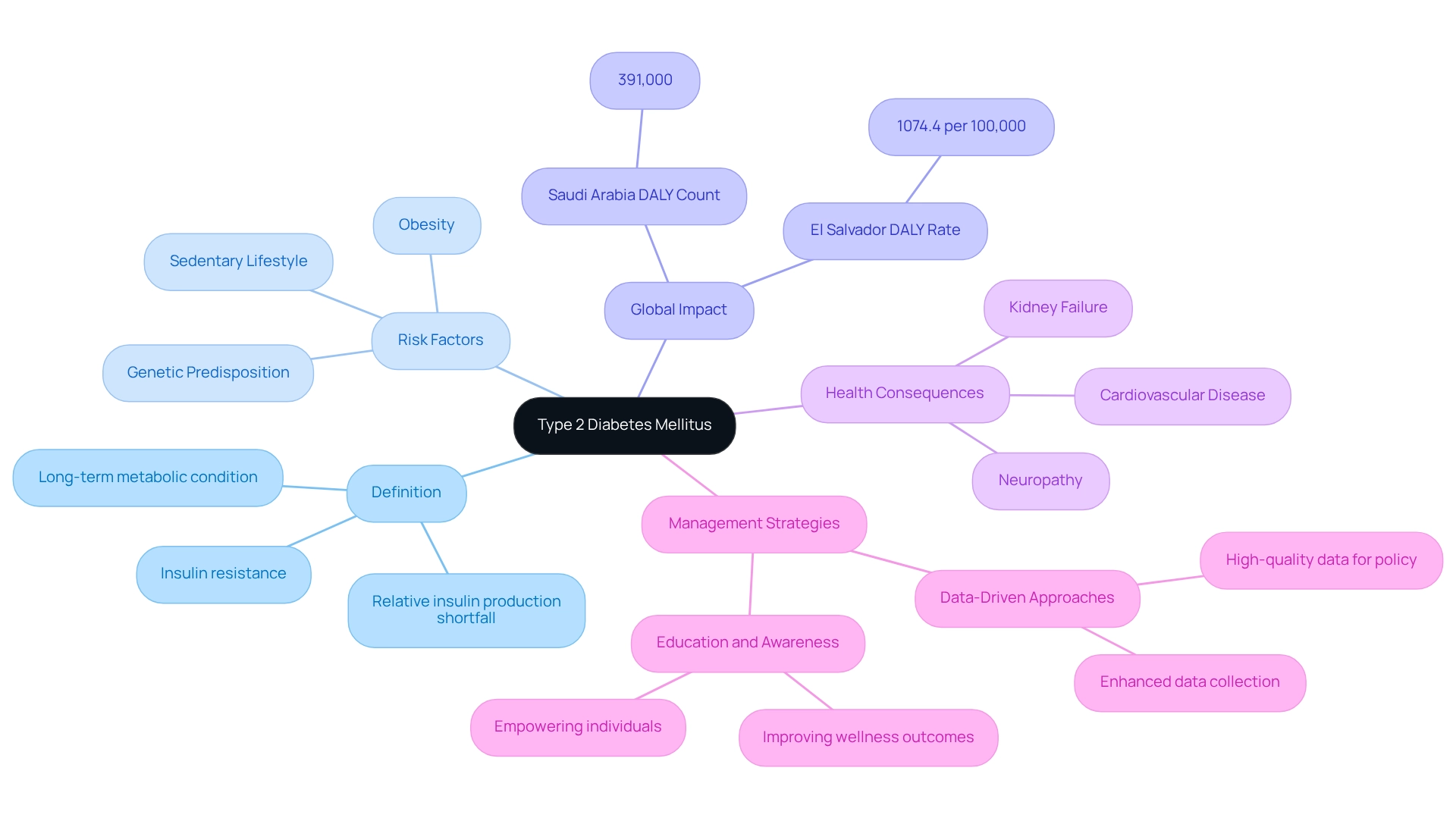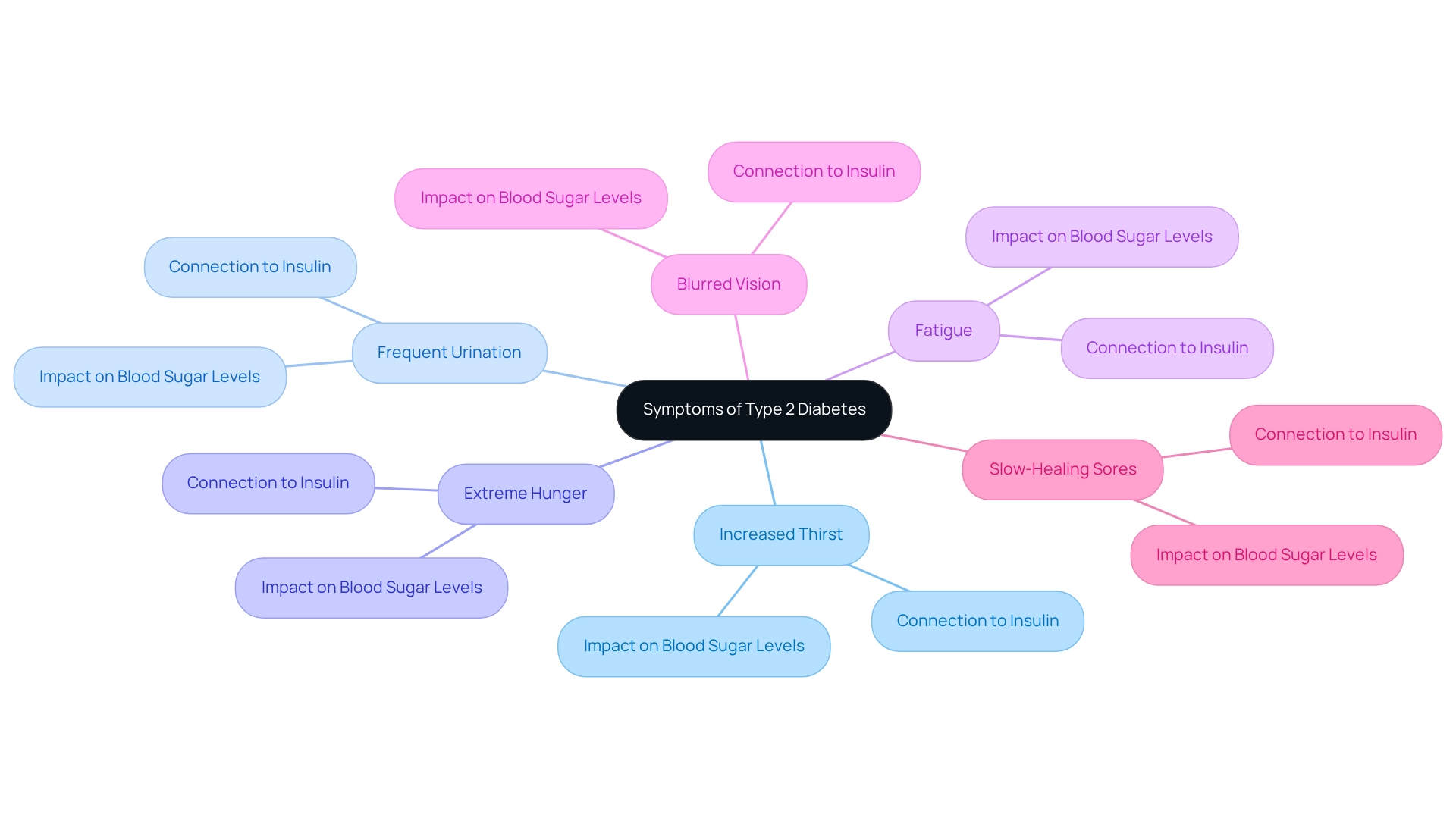Overview
Type 2 Diabetes Mellitus is a long-term metabolic condition that can feel overwhelming. It is characterized by insulin resistance and elevated blood sugar levels, often linked to obesity and a sedentary lifestyle. Recognizing early symptoms, such as increased thirst and fatigue, is crucial. It's understandable to feel concerned about these changes in your body.
This article emphasizes the importance of early symptom recognition and advocates for a multifaceted management approach. By incorporating lifestyle changes and medications, individuals can improve their health outcomes. You’re not alone in this journey; many have found success through support and resources.
If you’re feeling uncertain, remember that there are steps you can take to manage your condition effectively. Seeking guidance from healthcare professionals and connecting with others who share similar experiences can be incredibly beneficial. We are here to support you every step of the way.
Introduction
In a world where chronic diseases are increasingly prevalent, Type 2 Diabetes Mellitus (T2DM) emerges as a significant health concern, impacting millions across the globe. This condition, characterized by insulin resistance and elevated blood sugar levels, not only presents serious health risks but also necessitates a compassionate understanding to manage effectively. As the prevalence of T2DM continues to rise—especially in regions like Saudi Arabia and El Salvador—the need for effective management strategies becomes more urgent than ever.
Recognizing early symptoms is crucial, and exploring diverse treatment options can pave the way toward better health outcomes for those living with T2DM. It's understandable to feel overwhelmed by this diagnosis, but know that this journey is critical and you are not alone. This article aims to illuminate the complexities of Type 2 Diabetes, sharing insights into its symptoms, management strategies, and the essential role of ongoing education and awareness. Together, we can navigate this path toward improved health and well-being.
Define Type 2 Diabetes Mellitus: Understanding the Condition
What is type 2 diabetes mellitus? It is a long-term metabolic condition that can feel overwhelming. It is characterized by resistance to insulin and a relative shortfall in hormone production, which leads to increased blood sugar levels. Unlike Type 1 Diabetes, where insulin production is absent, individuals with Type 2 Diabetes can produce insulin; however, their bodies do not utilize it effectively. This condition typically develops gradually and is linked to several risk factors, including obesity, a sedentary lifestyle, and genetic predisposition.
It's concerning to know that millions worldwide are impacted by Type 2 Diabetes. For instance, in Saudi Arabia, the disability-adjusted life years (DALY) count reached 391,000, highlighting the urgent need for effective strategies to manage diabetes-related health issues. In El Salvador, the age-standardized DALY rate was reported at 1074.4 per 100,000, further emphasizing the global impact of this condition. Understanding what is type 2 diabetes mellitus is essential because uncontrolled blood sugar can lead to serious health issues, such as cardiovascular disease, kidney failure, and neuropathy. Recent research highlights the importance of addressing insulin resistance, which is a key characteristic of what is type 2 diabetes mellitus, as it plays a pivotal role in the disease's progression.
Case studies, including those emphasized by the Lancet Commission on sugar intolerance, highlight the significance of high-quality data to guide policy choices and enhance care for this condition, especially in low- and middle-income nations. Enhanced data collection and analysis can lead to a better understanding of diabetes risks and needs, ultimately resulting in more effective interventions, especially as ongoing research seeks to answer what is type 2 diabetes mellitus by 2025. Experts stress the necessity for thorough education and awareness to empower individuals in managing their condition effectively. By promoting a deeper comprehension of T2DM and its consequences, we can strive for improved wellness outcomes for those impacted. Remember, you're not alone in this journey; we are here to support you every step of the way.

Identify Symptoms of Type 2 Diabetes: Recognizing Early Signs
If you’re experiencing increased thirst, frequent urination, extreme hunger, fatigue, blurred vision, or slow-healing sores, it’s important to understand what is type 2 diabetes mellitus, as these could be common symptoms. These signs arise from the body’s struggle to effectively use insulin, leading to elevated blood sugar levels. For instance, as your kidneys work to filter excess glucose from your bloodstream, you may notice increased thirst and urination.
Recognizing these early signs is crucial. Unfortunately, many people overlook these symptoms, often attributing them to other health issues, which can delay essential medical intervention. It’s understandable to feel uncertain, but awareness can empower you to take charge of your health. Endocrinologists stress that early recognition of these symptoms can significantly influence management and treatment outcomes. Research shows that what is type 2 diabetes mellitus often results from a combination of genetic predisposition and lifestyle factors, such as excess body fat and high blood pressure. By addressing these risk factors early on, you can take proactive steps toward prevention and management. Recent findings indicate that 8.0% of adults with diabetes-related conditions had a non-HDL cholesterol level of 190 mg/dL or higher, highlighting the link between these symptoms and overall well-being.
By understanding and acknowledging these early signs, you can take meaningful steps toward managing your health effectively. Remember, you’re not alone in this journey. T2DSolutions aims to be a comprehensive resource for Type 2 diabetes education and community support, guiding you with informed insights and assistance as you navigate your wellness journey.

Examine Treatments for Type 2 Diabetes: Management Strategies
To understand what is type 2 diabetes mellitus, managing it effectively requires a compassionate, multifaceted approach that combines lifestyle changes with medications. It's important to focus on adopting a balanced diet rich in whole foods, engaging in regular physical activity, and maintaining a healthy weight. Medications like metformin are crucial for controlling blood sugar levels, and studies have shown they can significantly improve glycemic control. In some cases, insulin therapy may be necessary to achieve the best results.
Continuous monitoring of blood glucose levels is essential for effective management. This practice empowers individuals to make informed decisions about their health. Research highlights that to prevent T2DM, it is essential to understand what is type 2 diabetes mellitus and prioritize lifestyle changes, such as dietary adjustments and increased physical activity. For example, the PREDIMED-Plus Trial revealed significant weight loss and improvements in glucose metabolism among participants who embraced a Mediterranean diet alongside exercise.
Real-world examples show how these strategies can work. Community health programs emphasize the importance of cultural contexts in creating supportive interventions that promote lifestyle changes. Such initiatives have been promising in reducing diabetes incidence, especially among high-risk populations.
As T2DSolutions launches as a new resource hub for diabetes education, it aims to support newly diagnosed patients by providing comprehensive information and community support. Experts agree that a holistic approach to diabetes management is vital. Nutritionists advocate for dietary recommendations centered on whole foods and balanced meals, while lifestyle changes are crucial for enhancing overall health outcomes. By embracing these comprehensive strategies, individuals can significantly lower their risk of complications associated with what is type 2 diabetes mellitus (T2DM) and improve their quality of life. Remember, you're not alone in this journey—we are here to support you every step of the way.

Conclusion
Type 2 Diabetes Mellitus (T2DM) is a complex and increasingly prevalent health issue that requires our attention and understanding. This article has highlighted critical aspects of T2DM, beginning with a clear definition of the condition and its alarming global prevalence, particularly in regions like Saudi Arabia and El Salvador. Recognizing the symptoms early is essential; it can lead to timely interventions that significantly improve health outcomes. Increased awareness of signs—such as excessive thirst, frequent urination, and fatigue—can empower you to seek medical advice sooner rather than later.
Management strategies for T2DM involve a multifaceted approach, including lifestyle modifications, dietary changes, and appropriate pharmacological treatments. By emphasizing the importance of a balanced diet and regular physical activity, we showcase how these strategies can effectively control blood sugar levels and enhance overall health. Community-based initiatives and educational resources, like T2DSolutions, play a vital role in supporting individuals on their health journey, ensuring access to necessary information and guidance.
Ultimately, the fight against Type 2 Diabetes requires a collective effort to raise awareness, promote education, and foster supportive environments. By understanding the complexities of T2DM and implementing effective management strategies, you can take charge of your health, reduce the risk of complications, and lead a fuller, healthier life. While the path may be challenging, remember that with the right tools and support, a positive outcome is achievable. You're not alone in this journey; we are here to support you every step of the way.
Frequently Asked Questions
What is type 2 diabetes mellitus?
Type 2 diabetes mellitus is a long-term metabolic condition characterized by insulin resistance and a relative shortfall in insulin production, leading to increased blood sugar levels. Unlike Type 1 Diabetes, individuals with Type 2 Diabetes can produce insulin but do not utilize it effectively.
How does type 2 diabetes develop?
Type 2 diabetes typically develops gradually and is associated with several risk factors, including obesity, a sedentary lifestyle, and genetic predisposition.
What are the global impacts of type 2 diabetes?
Millions of individuals worldwide are affected by type 2 diabetes. For example, in Saudi Arabia, the disability-adjusted life years (DALY) count reached 391,000, while in El Salvador, the age-standardized DALY rate was reported at 1074.4 per 100,000.
What are the health risks associated with uncontrolled blood sugar in type 2 diabetes?
Uncontrolled blood sugar can lead to serious health issues such as cardiovascular disease, kidney failure, and neuropathy.
Why is insulin resistance significant in type 2 diabetes?
Insulin resistance is a key characteristic of type 2 diabetes and plays a pivotal role in the progression of the disease, making it crucial to address in management strategies.
What is the importance of data collection in managing type 2 diabetes?
Enhanced data collection and analysis can lead to a better understanding of diabetes risks and needs, resulting in more effective interventions, particularly in low- and middle-income nations.
What is the role of education and awareness in managing type 2 diabetes?
Thorough education and awareness are essential to empower individuals in managing their condition effectively, promoting a deeper understanding of type 2 diabetes and its consequences for improved wellness outcomes.



